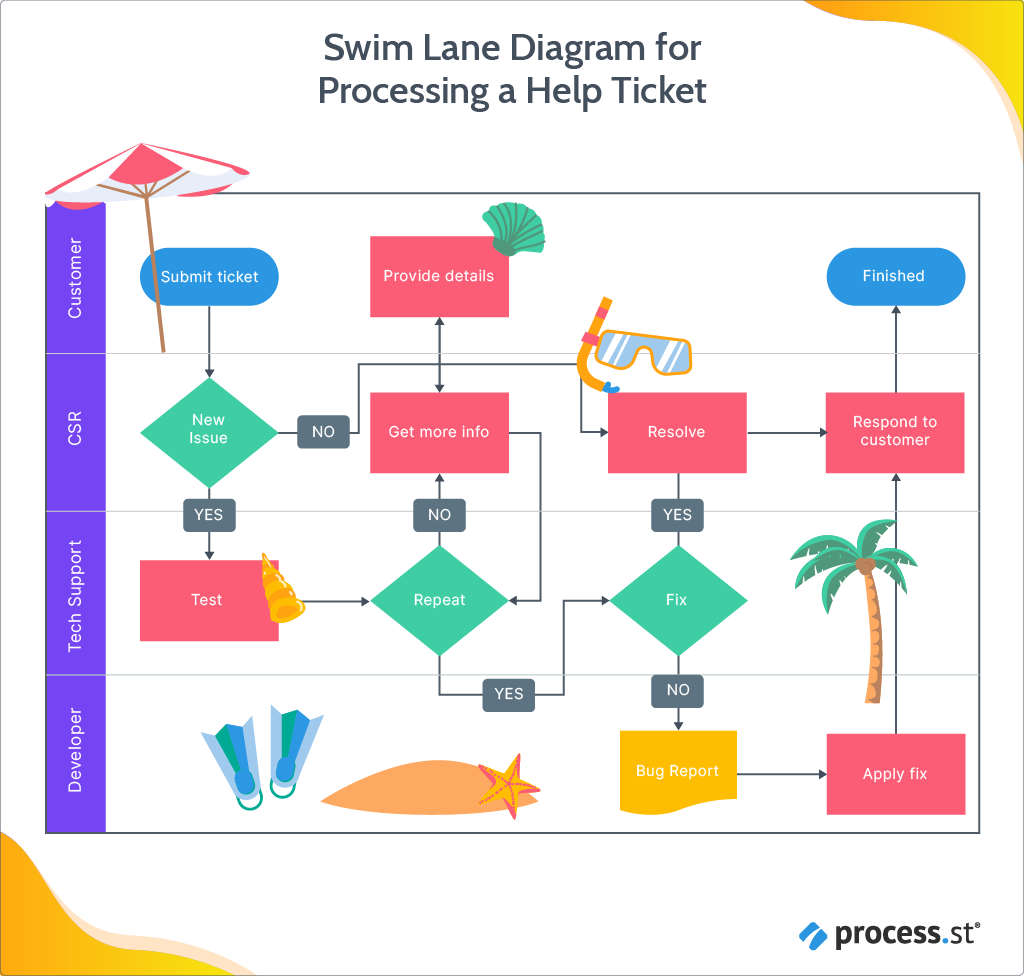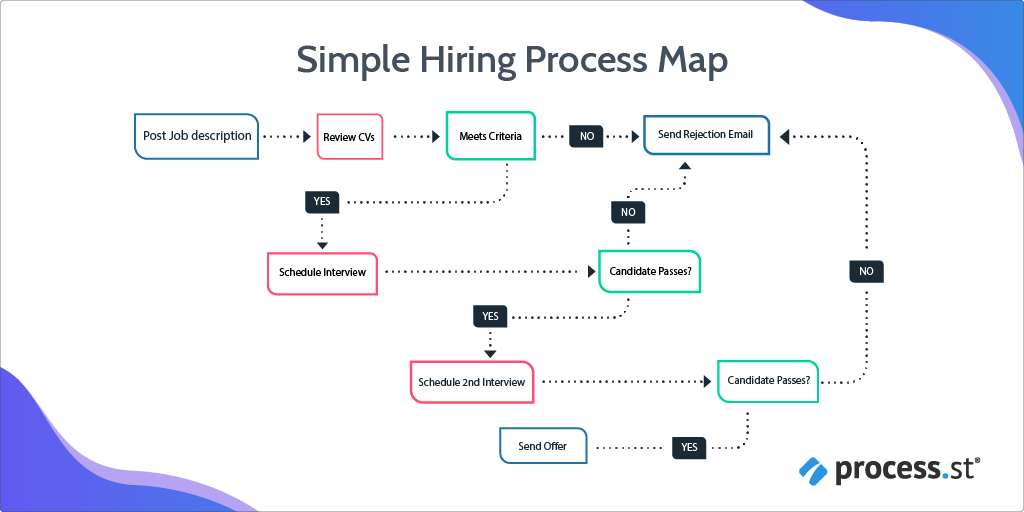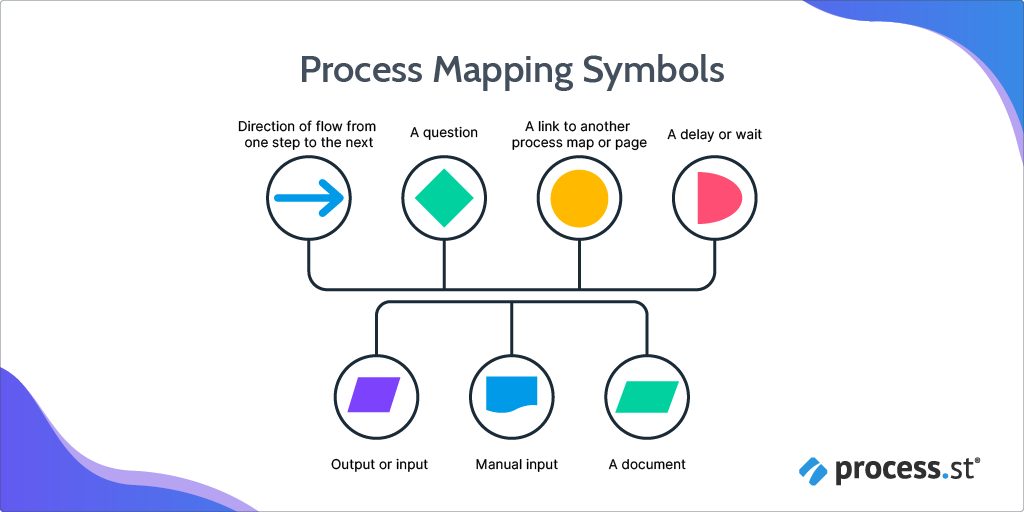Get started quickly, see results immediately, no code needed.
The Best Process Mapping Template Guide to Get You Started
So you’ve heard about process mapping but you don’t understand why you need it or how to do it.
Don’t worry, you’re not alone. Getting started is the hardest part and I’m here to guide you.
Let’s take a look at why you should be process mapping, how to do it, and the best practices. I’ll walk you through an entire process map template and break down how we made it.
Definition of process mapping
Process mapping is a valuable tool used in business process management to visually illustrate the flow of a specific process from start to finish. It involves creating a detailed representation of the steps, activities, inputs, outputs, and responsibilities involved in executing a process within an organization.
The goal of process mapping is to provide a clear and comprehensive overview of a process, enabling individuals to understand how it functions and identify areas for improvement. It helps in identifying inefficiencies, bottlenecks, unnecessary steps, and opportunities for streamlining and optimization.
A process map typically includes various elements such as symbols, shapes, and arrows to visualize the flow of activities, decisions, and information. It provides a visual representation of the process, making it easier to comprehend and analyze.
Process mapping provides insight into process flow by highlighting the sequence of steps, the interactions between different departments or functional units, and the roles and responsibilities of individuals involved. It helps in depicting the flow of materials, information, and resources, as well as the inputs, outputs, and dependencies between different steps.
Process mapping is beneficial for both project managers and employees involved in executing the process. It helps project managers gain a comprehensive understanding of the current process status, identify bottlenecks, and make informed decisions to improve efficiency.
Employees benefit from process mapping by gaining clarity on their roles and responsibilities, understanding the overall process flow, and identifying areas for process improvements.
Benefits of using process map templates
Using a process mapping template offers numerous benefits for businesses of all sizes. It serves as a valuable tool that aids in documenting, analyzing, and improving business processes. Here are some of the key benefits of using a process mapping template:
Clear visualization of processes
Process mapping templates provide a visual representation of workflows, making it easier for individuals to understand the entire process from start to finish. By using symbols, shapes, and arrows, the template creates a clear and concise overview that helps to eliminate confusion and fosters better communication between team members.
Identify inefficiencies and bottlenecks
With a process mapping template, businesses can easily identify inefficiencies and bottlenecks within their processes. By visualizing the flow of activities, decision points, and information, companies can pinpoint areas where delays, redundancies, or unnecessary steps occur. This insight allows for targeted process improvements to increase efficiency and productivity.
Streamline and optimize processes
Process mapping templates enable businesses to streamline and optimize their processes. By identifying unnecessary steps or redundancies, companies can eliminate waste and improve the overall flow of operations. This optimization can lead to cost savings, shorter cycle times, and improved customer satisfaction.
Enhance collaboration and teamwork
Process mapping templates facilitate collaboration and teamwork among employees. By providing a clear visual representation of the process, the template helps individuals understand their roles and responsibilities within the larger workflow. This understanding promotes effective collaboration, as team members can easily see how their work impacts the overall process and can work together to improve it.
Documentation and process standardization
Process mapping templates serve as documentation tools for capturing and standardizing processes within an organization. By documenting processes in a standardized template, businesses can ensure consistency in how tasks are performed, reducing the risk of errors or variations. This documentation also helps new employees quickly understand and learn the processes, ensuring smooth onboarding and knowledge transfer.
Continuous process improvement
Using a process mapping template encourages a culture of continuous improvement within an organization. By regularly reviewing and updating the process map, businesses can identify areas for further optimization and implement changes accordingly. This iterative process allows companies to stay agile and adapt to changing market conditions, resulting in enhanced efficiency and competitiveness.
Why is process mapping useful?
It’s simple: Process mapping makes everything better. Here’s how:
Identifies inefficiencies
It’s easy for inefficiencies to occur in a process and because of that, it’s important to take a step back to try and identify any that have occurred.
Process maps essentially give you an outside view of your operations, which makes it easy to identify the problem areas.
Once the inefficiencies are known, you can take steps to fix them. If your company tries to stay true to the principle of continuous improvement, then process maps are an excellent tool to help you achieve that. No process is 100% perfect, but effective mapping can get them pretty darn close.
Delegate tasks
Sometimes we don’t realize that the wrong people are working on a task. Or that one department or one person is taking on too much.
When you get that outside perspective from the process map, you can begin to delegate the tasks better. You ensure that the right people are working on the tasks suited for them and that the workload is balanced. Doing that can also lead to less burnout in your team, which is a double win.
Improve communication
A stagnant process and “this is how we’ve always done it” attitude can be the death of good communication. But process charts can help bring it back to life.
By taking away any confusion about who is supposed to do what within a process, your maps will open doors for your team that will promote better communication. You can even add communication as a task in your processes to really drive home the point.
Simplify processes
Often processes get overcomplicated, which can cause many problems. These include decreased efficiency and poor communication.
That’s where process maps come to the rescue. You can break down complicated ideas into smaller, simpler steps that make everything easier.
Increase employee happiness
Simplified, standardized, and efficient processes which promote good communication are ingredients that, when combined, make employees very happy.
No one wants to work in a frustrating environment brought on by bad processes and leadership that doesn’t want to improve them. It’s a recipe for high rates of churn.
Happy employees are loyal employees. Spend some time working with them to improve your processes and watch them shine! I guarantee they already have ideas.
Types of process maps
When it comes to process mapping, there are several types of process maps that businesses can utilize to gain a comprehensive understanding of their workflows. Each type of process map serves a specific purpose and provides unique insights into the intricacies of a business process. Let’s explore some of the most commonly used types of process maps:
Basic flowchart
This type of process map is the most straightforward and commonly used. It uses standardized flowchart symbols to represent the sequence of activities in a process. Basic flowcharts provide a high-level view of the process, showing the overall flow and sequence of steps.
Detailed process map
As the name suggests, this type of process map offers a more granular view of the process. In addition to the sequence of activities, it includes more detailed information such as inputs, outputs, decision points, and the roles responsible for each step. Detailed process maps are especially useful for identifying bottlenecks, redundancies, and inefficiencies within a process.
Deployment flowchart
This type of process map focuses on the allocation of resources and responsibilities for each step of the process. It helps businesses understand who is responsible for each task and how resources are utilized throughout the process. Deployment flowcharts are particularly beneficial for project managers and teams to ensure accountability and effective resource allocation.
Value stream map
Value stream maps provide a visual representation of the entire end-to-end workflow, highlighting the flow of materials, information, and value-added activities. This type of process map is commonly used in lean manufacturing environments to identify non-value-added activities, eliminate waste, and streamline the value stream.
Swim lane map
Swim lane maps are process maps that organize activities based on the functional units or departments involved in the process. This type of process map is useful for providing clarity and understanding of cross-functional workflows, as it clearly shows how different departments or individuals interact and collaborate throughout the process.

Workflow diagram
Workflow diagrams are visual representations of the steps and decisions involved in a process. They focus on the logical flow of activities and provide a detailed understanding of the process sequence. Workflow diagrams are widely used in project management to ensure that all necessary steps and dependencies are identified and incorporated into the project plan.
Elements of a process mapping template
When it comes to creating an effective process mapping template, there are several key elements that you should include. These elements help to provide a clear and comprehensive understanding of the process, its steps, and its stakeholders. By carefully considering and incorporating these elements, you can create a process mapping template that is not only visually appealing but also highly informative and useful.
Process steps
One of the fundamental elements of a process mapping template is the identification and description of each step in the process. These steps should be organized in a logical sequence to clearly show the flow of activities. Including a brief description for each step helps to provide clarity and context to anyone reviewing the process map.
Process flowchart symbols
In order to create a visual representation of the process, it is important to use standardized flowchart symbols. These symbols represent different activities, decision points, inputs, outputs, and connections between steps. By using these symbols consistently throughout the template, you can ensure that your process map is easily understandable and consistent with industry standards.
Roles and responsibilities
A process mapping template should also include information about the roles and responsibilities of individuals or departments involved in each step of the process. This helps to clarify who is responsible for completing each task and ensures that accountability is established. Clearly defining roles and responsibilities also helps to identify potential bottlenecks or areas where tasks may be duplicated or overlooked.
Key inputs and outputs
Understanding the inputs and outputs of each process step is crucial for gaining insight into the flow of materials, information, and value-added activities. Including this information in the process mapping template allows for a comprehensive analysis of the process and helps to identify any inefficiencies or opportunities for improvement.
Process boundaries
It is important to clearly define the start and end points of the process being mapped. This helps to set the boundaries within which the process operates and ensures that all relevant steps are included in the mapping template.
Process ownership
Assigning ownership for the overall process and each individual step is essential for effective process management. This helps to ensure that there is accountability for the success of the process and provides a clear point of contact for questions or issues that arise.
Techniques for creating a process mapping template

Creating an effective process mapping template requires careful consideration and a strategic approach. Here are some techniques that can help you in creating a comprehensive and user-friendly process mapping template:
Gather information
Before creating a process map, it is important to gather all the necessary information about the process. This includes understanding the steps involved, the people involved, inputs and outputs, decision points, and any other relevant details. This will help you create a more accurate and detailed process map.
Choose the right format
There are various formats for creating process maps, such as flowcharts, swim lane diagrams, or value stream maps. Select the format that best suits your needs and the complexity of the process. For simpler processes, a basic flowchart may be sufficient, while complex processes may require a more detailed swim lane diagram or value stream map.
Identify process boundaries
Clearly define the start and end points of the process and any subprocesses involved. This helps to set the boundaries of the process and ensures that all the relevant steps are included in the process map. It is important to capture all the core activities and understand how they contribute to the overall process.
Use visual symbols
Utilize standardized symbols and icons that represent different activities, decision points, inputs, outputs, and connections. This ensures consistency in the process map and helps users easily understand and interpret the information presented. There are numerous symbols available, such as arrows, rectangles, diamonds, and circles, each representing a specific action or decision.
Define roles and responsibilities
Clearly identify the roles and responsibilities of individuals or departments involved in each step of the process. This helps to establish accountability and ensures that everyone understands their role in executing the process. Assigning ownership for each step is essential for effective process management and continuous improvement.
Include key metrics
Consider including key metrics or performance indicators related to the process. This provides valuable insights into the efficiency and effectiveness of the process. Metrics such as cycle time, throughput, and quality can help identify bottlenecks or areas for improvement.
Review and refine
Once the initial process map is created, review it with key stakeholders and individuals involved in the process. Get their feedback and input to ensure accuracy and completeness. Refine the process map based on their suggestions and make sure it aligns with the actual workflow.

yone on board, you can take the process map and start using it as the blueprint by which you implement operational changes.
Process mapping best practices
To finish off, let’s cover some best practices for you to keep in mind as you embark on your process mapping journey.
Identify the problem
How are you going to fix a problem if you don’t know what it is? Take a look at the process you want to map and think:
- Does it have any inefficiencies?
- How is the communication?
- Have any employees complained recently?
- Have any customers complained recently?
- Are there any glaring bottlenecks?
You may get one or more problems that come from asking these questions, but don’t worry! Finding problems in your processes is a good thing because it’ll put you on the right track to fixing them and having the processes of your dreams.
Use symbols

There are a variety of symbols you can use to make your process map, each one representing something different.
- Box: A step in the process
- Arrow: Direction of flow from one step to the next
- Diamond: A question
- Circle: A link to another process map or page
- Half oval: A delay or wait
- Parallelogram: Output or input
- Angled rectangle: Manual input
- Wavy rectangle: A document
Use them to add details to your process map without using words. It makes a big difference!
Set clear objectives
Your process map isn’t going to fix anything if you don’t know what you want it to fix. This is why it’s important to identify the problems in your processes early on. By doing so, you’ll be able to set these clear objectives and use them as goals during your mapping.
Keep things simple
Remember that most process maps are meant to offer a bird’s eye view of a process. The tiny, intricate details don’t matter so much because that’s not where systemic problems lie.
Simplicity is key to good process mapping because it cleans everything up and gives you the most objective perspective possible to make positive changes. Doing less work will help you more in the long run.
Get feedback
We’ve already touched on this briefly, but it’s important so it bears repeating. There is nothing more valuable than feedback. And in the context of process mapping, your team’s feedback could make or break a process’s efficiency.
Involve them in the process mapping journey as much as possible and really take their ideas into consideration. They are the ones who put these processes into action and will have the best perspective on what changes to make.
Use standardized notations
When using tools like symbols and colors to make maps more specific, make sure to be consistent. We even recommend making a key for people to reference when taking a look at the process map.
Standardizing notations is the only way to get everyone on the same page.
Map alternative routes
If you are mapping a more complicated process, or you just want other options for running your processes, it’s good to map alternative routes.
It’s a good way to play around and think about processes from different angles to try and find the best route to take. It’s your opportunity to be creative and think outside the box!
You’re ready!
Now that you have all the information you need to get started, go forth and start mapping your processes!
Just stick to the principles we went through above and you’ll be creating the best processes your business has ever had. I believe in you!







 Workflows
Workflows Projects
Projects Data Sets
Data Sets Forms
Forms Pages
Pages Automations
Automations Analytics
Analytics Apps
Apps Integrations
Integrations
 Property management
Property management
 Human resources
Human resources
 Customer management
Customer management
 Information technology
Information technology


